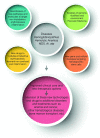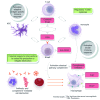The European Hematology Association Roadmap for European Hematology Research: a consensus document
- PMID: 26819058
- PMCID: PMC4938336
- DOI: 10.3324/haematol.2015.136739
The European Hematology Association Roadmap for European Hematology Research: a consensus document
Abstract
The European Hematology Association (EHA) Roadmap for European Hematology Research highlights major achievements in diagnosis and treatment of blood disorders and identifies the greatest unmet clinical and scientific needs in those areas to enable better funded, more focused European hematology research. Initiated by the EHA, around 300 experts contributed to the consensus document, which will help European policy makers, research funders, research organizations, researchers, and patient groups make better informed decisions on hematology research. It also aims to raise public awareness of the burden of blood disorders on European society, which purely in economic terms is estimated at €23 billion per year, a level of cost that is not matched in current European hematology research funding. In recent decades, hematology research has improved our fundamental understanding of the biology of blood disorders, and has improved diagnostics and treatments, sometimes in revolutionary ways. This progress highlights the potential of focused basic research programs such as this EHA Roadmap.The EHA Roadmap identifies nine 'sections' in hematology: normal hematopoiesis, malignant lymphoid and myeloid diseases, anemias and related diseases, platelet disorders, blood coagulation and hemostatic disorders, transfusion medicine, infections in hematology, and hematopoietic stem cell transplantation. These sections span 60 smaller groups of diseases or disorders.The EHA Roadmap identifies priorities and needs across the field of hematology, including those to develop targeted therapies based on genomic profiling and chemical biology, to eradicate minimal residual malignant disease, and to develop cellular immunotherapies, combination treatments, gene therapies, hematopoietic stem cell treatments, and treatments that are better tolerated by elderly patients.
Copyright© Ferrata Storti Foundation.
Figures








References
-
- De Benoist B, et al., eds. Worldwide prevalence of anemia 1993–2005. WHO Global Database on Anemia. Geneva, World Health Organization, 2008.
-
- Hanly P, Soerjomataram I, Sharp L. Measuring the societal burden of cancer: the cost of lost productivity due to premature cancer-related mortality in Europe. Int J Cancer. 2015;136(4):e136–145. - PubMed
-
- Eurostat. Luxembourg, Luxemburg. Causes of death, 2015. Available from: http://ec.europa.eu/eurostat/web/health/causes-death/data/database
-
- WHO, International Agency for Research on Cancer. Lyon, France. Cancer Factsheets. Available from: http://eco.iarc.fr/eucan/CancerSearch.aspx
-
- Döhner H, Stilgenbauer S, Benner A, et al. Genomic aberrations and survival in chronic lymphocytic leukemia. N Engl J Med. 2000;343(26):1910–1916 - PubMed
MeSH terms
Substances
Grants and funding
- 15692/CRUK_/Cancer Research UK/United Kingdom
- MC_UU_12009/8/MRC_/Medical Research Council/United Kingdom
- FS/09/039/27788/BHF_/British Heart Foundation/United Kingdom
- 11831/CRUK_/Cancer Research UK/United Kingdom
- 12765/CRUK_/Cancer Research UK/United Kingdom
- R01 DK095112/DK/NIDDK NIH HHS/United States
- MC_PC_15069/MRC_/Medical Research Council/United Kingdom
- MC_UU_12009/13/MRC_/Medical Research Council/United Kingdom
- R01 DK090554/DK/NIDDK NIH HHS/United States
- 19565/CRUK_/Cancer Research UK/United Kingdom
- R01 HL116329/HL/NHLBI NIH HHS/United States
- MC_U137981013/MRC_/Medical Research Council/United Kingdom
- MR/L022982/1/MRC_/Medical Research Council/United Kingdom
- MC_PC_12009/MRC_/Medical Research Council/United Kingdom
LinkOut - more resources
Full Text Sources
Other Literature Sources
Medical

